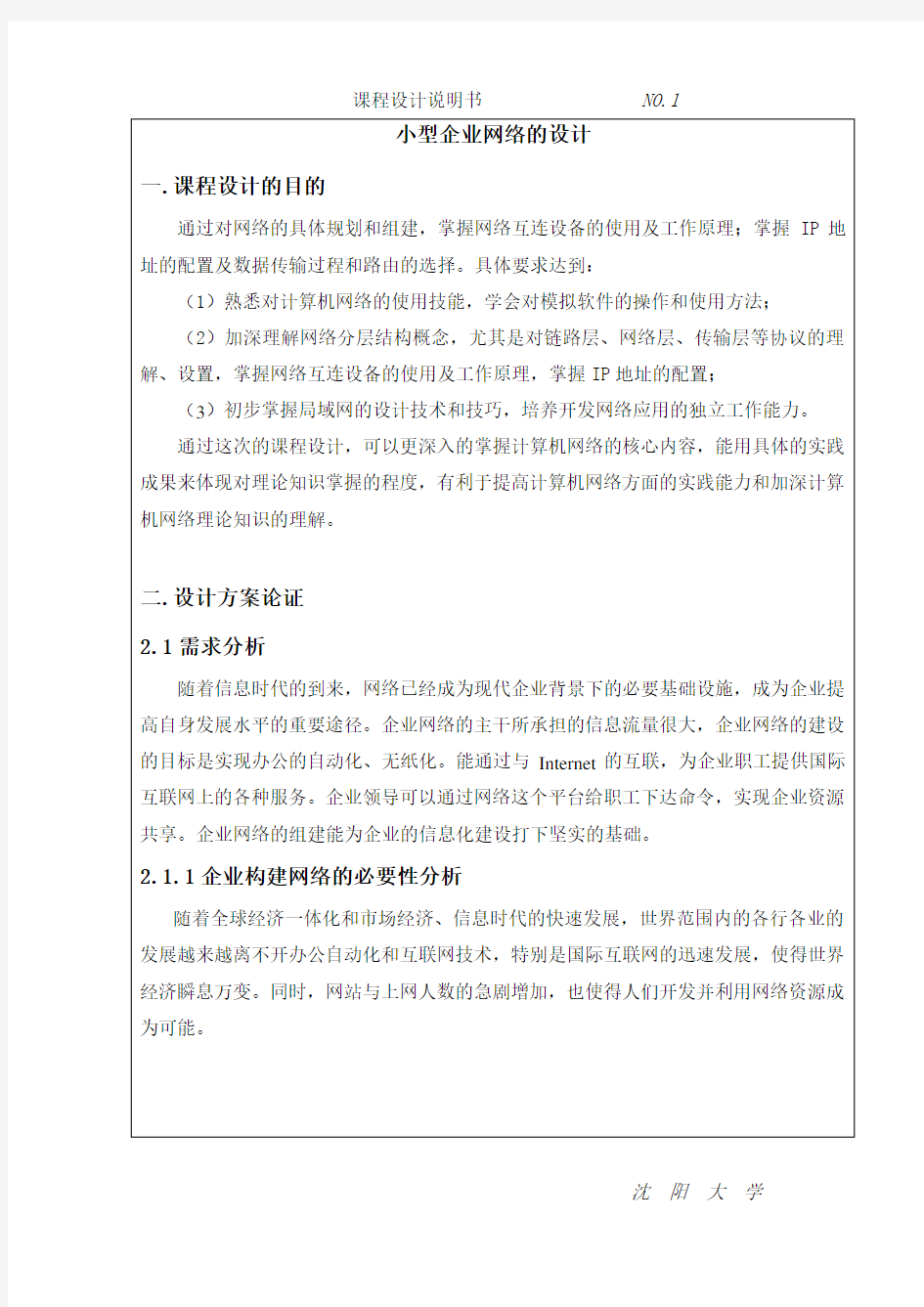计算机网络课程设计-小型企业网络的设计

- 1、下载文档前请自行甄别文档内容的完整性,平台不提供额外的编辑、内容补充、找答案等附加服务。
- 2、"仅部分预览"的文档,不可在线预览部分如存在完整性等问题,可反馈申请退款(可完整预览的文档不适用该条件!)。
- 3、如文档侵犯您的权益,请联系客服反馈,我们会尽快为您处理(人工客服工作时间:9:00-18:30)。
课程设计说明书 NO.1
课程设计说明书 NO2
沈阳大学
三、设计的过程与分析
3.1本企业网络设计的层次拓扑结构图如下图所示:
图1 网络结构拓扑图
图2 网络连接成功图(1)
图3 网络连接成功图(2)
图4 网络连接成功图(3)
3.2子网划分与局域网建立
IP地址规划和子网划分:
子网二:172.16.1.0/24
子网三:172.16.3.0/24
Router5:172.16.1.0
路由协议的选择: RIP路由协议
1.办公室20台的IP地址:17
2.16.2.3-172.16.2.23 2策划部30台的IP地址:172.16.
3.3-172.16.3.33 3人事部40台的IP地址:172.16.
4.3-172.16.4.43 4财务部30台的IP地址:172.16.
5.3-172.1
6.5.33
参考文献要列出3篇以上,格式如下:
[1]谢宋和,甘勇.单片机模糊控制系统设计与应用实例[M].北京:电子工业出版社, 1999.5:20-25
(参考书或专著格式为:
著者.书名[M].版本(第1版不注).出版地:出版者,出版年月:引文所在页码)
[2]潘新民,王燕芳.微型计算机控制技术[M],第2版.北京:电子工业出版社, 2003.4:305-350
(1本书只能作为1篇参考文献,不能将1本书列为多个参考文献)
[3]范立南,谢子殿.单片机原理及应用教程[M].北京:北京大学出版社, 2006.1:123-130
[4] Newman W M, Sbroull R F. Principles of Interactive Computer Graphics[M]. New York: McGraw Hill, 1979.10:10-25
[5]卜小明,龙全求.一种薄板弯曲问题的四边形位移单元[J].力学学报, 1991,23(1):53-60
(参考期刊杂志格式为:
作者.论文题目[J].期刊名,出版年,卷号(期号):页码)(期刊名前不写出版地)
[6]Mastri A R. Neuropathy of diabetic neurogenic bladder[J]. Ann Intern Med, 1980, 92(2):316-318
[7]范立南,韩晓微,王忠石等.基于多结构元的噪声污染灰度图像边缘检测研究[J].武汉大学学报(工学版), 2003,49(3):45-49
[8] index.asp
(一般情况下不要用网址作为参考文献,如果用,最多1个)
注:[M]表示参考的是书籍;[J]表示参考的是学术期刊的论文;如果参考会议论文集中的论文用[C]。
要求:
全部打印在A4纸(二本),各级标题四号宋体加粗,正文文字小四号宋体,程序五号times new roman,字数3000字以上,15页以上。
严禁抄袭,如有雷同者,均按不及格论处
注:本页不用打印附录:外文翻译
In Wang Zuoliang’s translation practices, he translated many poems, especially the poems written by Robert Burns. His translation of Burn’s “A Red, Red Rose” brought him fame as a verse tra nslator. At the
same time, he published about ten papers on the translation of poems.
Some argue that poems cannot be translated. Frost stresses that poetry might get lost in translation. According to Wang, verse translation is possible and necessary, fo r “The poet-translator brings over some exciting work from another culture and in doing so is also writing his own best work, thereby adding something to his culture. In this transmission and exchange, a richer, more colorful world emerges. ”(Wang, 1991:112).
Then how can we translate poems? According to Wang’s understanding, the translation of poems is related to three aspects: A poem’s meaning, poetic art and language.
(1)A poem’s meaning
“Socio-cultural differences are formidable enough, but the matter is made much more complex when one realizes that meaning does not consist in the meaning of words only, but also in syntactical structures, speech rhythms, levels of style.” (Wang, 1991:93).
(2)Poetic art
According to Wang, “Bly’s point about the ‘marvelous translation’ being made possible in the United States only after Whitman, Pound and Williams Carlos Williams composed poetry in speech rhythms shows what may be gained when there is a genuine revolution in poetic art.” (Wang, 1991:93).
(3)Language
“Sometimes language stays static and sometimes language stays active. When language is active, it is beneficial to translation”“This would require this kind of intimate understanding, on the part of the translator, of its genius, its idiosyncr asies, its past and present, what it can do and what it choose not to do.” (Wang, 1991:94).
Wang expresses the difficulties of verse translation. Frost’s comment is sufficient to prove the difficulty a translator has to grapple with. Maybe among literary translations, the translation of poems is the most difficult thing. Poems are the crystallization of wisdom. The difficulties of poetic comprehension lie not only in lines, but also in structure, such as cadence, rhyme, metre, rhythm, all these conveying information. One point merits our attention. Wang not only talks about the times’ poetic art, but also the impact language’s activity has produced on translation. In times when the language is active, translation is prospering. The reform of poetic art has improved the translation quality of poems. For example, around May Fourth Movement, Baihua replaced classical style of writing, so the translation achieved earth-shaking success. The relation between the state of language and translation is so
